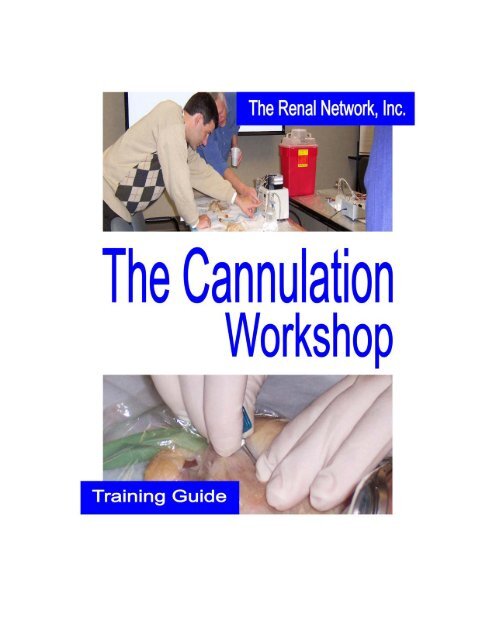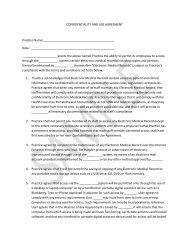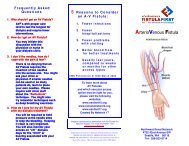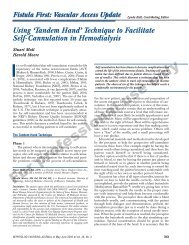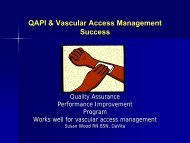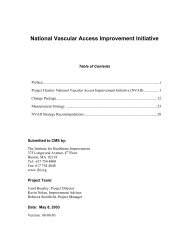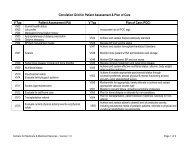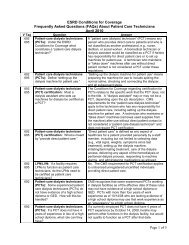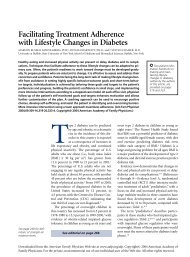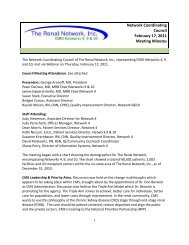Training Guide - The Renal Network
Training Guide - The Renal Network
Training Guide - The Renal Network
You also want an ePaper? Increase the reach of your titles
YUMPU automatically turns print PDFs into web optimized ePapers that Google loves.
<strong>The</strong> Cannulation Workshop <strong>Training</strong> <strong>Guide</strong>A Resource for Staff <strong>Training</strong> and EducationCannulation Simulation Laboratory DesignGordon McLennan, MD, Indiana University-Purdue University of IndianapolisCarmen Lowden, BS, RN, CNN, Indiana Kidney InstitutePatricia Coryell, RN, CNN (formerly with <strong>The</strong> <strong>Renal</strong> <strong>Network</strong>, Inc.)Cannulation Simulation Laboratory Program AdvisorsCatherine Colombo, RN, CNN, Fresenius Medical CareRonald E. Fraley, RN, MBA, MFS, Indiana University-Purdue University of IndianapolisWendy Jagusch, RN, Centers for Dialysis CareRaynel Kinney, RN, CNN, CPHQ, <strong>The</strong> <strong>Renal</strong> <strong>Network</strong>, Inc.Linda Smith, RN, NP, Indiana University HospitalMary Showers, RN, CNN, Centers for Dialysis CareLisa Stiffler, RN, BSN, CNN, FMC-Dialysis Institute of Indiana<strong>The</strong> <strong>Renal</strong> <strong>Network</strong>, Inc.Susan A. Stark, Executive DirectorQuality Improvement DepartmentRaynel Kinney, RN, CNN, CPHQ, Quality Improvement DirectorMary Ann Webb, MSN, RN, CNN, Quality Improvement CoordinatorJanie Hamner, Quality Improvement AssistantAcknowledgements<strong>The</strong> <strong>Renal</strong> <strong>Network</strong>, Inc. wishes to gratefully acknowledge the contributions of the manypeople who have made this Cannulation Simulation Laboratory Workshop model asuccess. Our special thanks go to the renal dialysis staff and renal patients who helpedto field test this model. We also appreciate those who have generously givenpermission to include their articles and materials in the accompanying CannulationWorkshop Resource CD-ROM.Thank you to all the <strong>Network</strong> staff who contributed to the writing of this booklet.
Table of ContentsIntroduction 1Section 1: Program Development 2Section 2: Program Modules 5Section 3: Cannulation Lab Preparation Procedure 10Section 4: <strong>Training</strong> Tips 12Section 5: Program Evaluation 16Section 6:<strong>Training</strong> Kit Feedback Form 17Section 7: Resources 18
IntroductionThis guide is part of the Cannulation Workshop <strong>Training</strong> Kit which brings together threenew resources to assist dialysis educators in developing an in-house training programfor facility staff on vascular access cannulation.1. <strong>The</strong> Cannulation Workshop DVD contains four video segments. <strong>The</strong> first threesegments are lecture presentations including:• An anatomy/physiology presentation by a physician.• An access assessment presentation by a nurse.• A patient/staff communication model presented by a nurse.<strong>The</strong>se presentations are part of a laboratory-style cannulation simulationworkshop developed by <strong>The</strong> <strong>Renal</strong> <strong>Network</strong>, Inc.<strong>The</strong> fourth video segment is the set-up demonstration for the cannulationlaboratory stations. <strong>The</strong> cannulation simulation offers a unique hands-on methodfor training in the placement of access needles and fistula assessment byproviding the opportunity to practice puncturing collapsible structures similar tothe native fistula.2. A Cannulation Workshop Resource CD-ROM contains PowerPoint slides of theworkshop presentations, sample protocols and articles on cannulation techniquesand vascular access assessment and management.3. <strong>The</strong> Cannulation Workshop <strong>Training</strong> <strong>Guide</strong> offers program modules based on theoriginal workshop. <strong>The</strong>se modules can be used as templates in the developmentof your own training program. In addition, this guide offers some generalinformation on how adults learn and provides practical tips for making theenvironment conducive to learning. A sample program evaluation and aresource list are also included.Please keep in mind that this is just a guide; it can be altered and changed to suit theneeds of your dialysis facility or corporate education program. In addition, you maywant to include your own facility cannulation tools and resources, and reference thesethroughout the training program.1
Section 1: Program DevelopmentAs you begin to plan your program, consider the following:A. Identify the goals of your workshop before you begin developing the agendato ensure that your workshop is as focused as possible.<strong>The</strong> goal of <strong>The</strong> <strong>Renal</strong> <strong>Network</strong>’s Cannulation Workshop is to create and promote abaseline of knowledge regarding expert cannulation techniques and accesspreservation, monitoring, and maintenance. <strong>The</strong> specific objective of the workshop is toprepare hemodialysis staff trainees in hemodialysis access assessment andcannulation, and to reinforce cannulation skills in veteran hemodialysis staff members.B. Identify which modules you will need to meet your identified goals.Each module is designed to take the learner through the cannulation process in a stepby-stepfashion. <strong>The</strong> modules include a topic discussion, video presentation, resourcesand tools, suggested readings, and an option to invite guest speakers.C. Set the length of time available for a workshop. Will you need a single-day ormultiple-day format?<strong>The</strong> whole cannulation program, as outlined, can be delivered in a four- to five-hour timeframe. <strong>The</strong> single-day program agenda provided lists all of the program modules of thecannulation training and gives an approximate time frame for the delivery of each topic.If you are unable to devote four to five hours to a workshop or prefer to present theprogram in shorter segments over several days, the individual program modules may beused as stand alone workshops.This program-module approach provides you with flexibility in setting the length of theprogram and the amount of information provided in each session. Select only themodules that you will need. Feel free to expand or substitute the content of a modulewith materials that address specific challenges or conditions in your dialysis orcorporate structure.2
Section 1: Program Development continuedD. Select your program modules* and set your agenda.Session One: Fistula 101Fistula 101 discusses “What is a fistula?” and “Why is it the access of choice?”Topics include a detailed anatomical and physiological overview of the fistula includingevaluation, assessment and management of the new and mature fistula, fistulaproblems and how to handle fistula failure.Session Two: Fistula Assessment and CannulationFistula assessment, before and after cannulation, will be discussed from a direct carepractitioner’s perspective. Appropriate cannulation techniques and troubleshooting arealso discussed.Session Three: Positive Fistula CommunicationAddressing patient concerns and misconceptions about fistula placement, evaluationand maintenance is critical to vascular access management. This session presentssuggested responses and encouraging comments designed to assist staff in beingpositive in their approach to patient concerns.Each of the above sessions will be structured with a) objectives for the session,b) session topics, c) the presentation and handouts related to the session,d) discussion points, e) suggested readings, and f) tips for the educator.Session Four: Cannulation LabPractice needle placement using the cannulation simulation stations.Facilitators will need to review <strong>The</strong> Cannulation Lab Preparation Procedure included inthis training guide. This section provides a list of the equipment needed to create thecannulation laboratory-style simulation station and the procedure for set-up of thestation. A video of the set-up procedure is also presented on the CannulationWorkshop DVD.* See Multiple Day Program (Section 2) sessions for specific program module details.3
Section 1: Program Development continuedE. Identify your facilitators/patient panel/discussion leaders/local experts asneeded. (Some parts of the workshop program are discretionary.)Patient Panel<strong>The</strong> development of a patient panel works best when the patients invited reflect thediversity of the local population. Also the patients selected should have a range ofaccess types representing the problems and successes that staff face on a day-to-daybasis. Most patients are comfortable telling their stories, but it is important to let eachpatient know exactly what aspect of the story you would like them to tell. Give themquestions to use as prompts. For example:1. What concerns did you have about getting a fistula?2. How did you overcome your fears?3. How did staff help you?Let patients know how much time they have to speak individually and as a group. Youmay wish to let each patient take a few moments to tell their story and then askquestions to which they all respond. Questions may come from the moderator or fromthe participants.Local SpeakersYou may wish to use local speakers either to make a presentation or to lead adiscussion on a selected topic. When selecting a local speaker it is important to shareyour goals for the training program and discuss the specific themes or issues you wouldlike to address. Using an outside speaker may be especially important when you wantto introduce new techniques or methods. <strong>The</strong>re are times when “one of your own” maybe capable of doing the job but may find it difficult to be “a prophet in their own house.”Talking PointsTalking points make it easier to summarize the main points in your training program.Outlining talking points makes it easier to facilitate a discussion and respond toquestions when the opportunity presents itself.Additional Reading MaterialsAdd additional resources to any section of the training program you may wish toemphasize or develop further.4
Section 2: Program ModulesSingle-Day Program*Fistula 101Assessment /EvaluationCommunicationI. “Cannulation Techniques for Arteriovenous Fistulae”presented by Dr. Gordon McLennan(Cannulation Workshop DVD - Chapter 1)approximately45 minutesII. Continued AVF Overview discussion approximately30 minutesIII. Optional Q&A with Interventional Radiologist approximately30 minutesIV. “Internal A-V Access Assessment”approximatelypresented by Catherine Colombo, RN, CNN30 minutes(Cannulation Workshop DVD - Chapter 2)V. Continued Access Assessment discussion approximately30 minutesVI.VII.Patient Experience with Guest AVF Patient for “hands-on”assessment and Q&A“Is Your Access Language a Barrier?”presented by Catherine Colombo, RN, CNN(Cannulation Workshop DVD - Chapter 3)VIII. Group discussion: “How would you respond to thesestatements?”approximately30 minutesapproximately15 minutesapproximately15 minutesLab PracticeIX. Cannulation Practice – Using laboratory-style cannulationsimulation station(s)(Facilitators see Cannulation Workshop DVD - Chapter 4for simulation station set-up)approximately30 to 60minutesX. Optional Q&A with Master Cannulator – approximately30 minutes*See Multiple Day Program sessions for specific program module details.5
Section 2: Program Modules continuedMultiple-Day ProgramSession Objectives:At the completion of this session, the learner will be able to:• Define a fistula• Explain the importance of a fistula• Discuss the evaluation of a new and/or a matured fistula• Outline specific approaches to deal with/treat fistula failureSession Topics:• What is a fistula?• Fistula evaluation• Approaches to fistula failureSession One: Fistula 101DVD Presentation:• “Cannulation Techniques for Arteriovenous Fistulae” presented by Dr.Gordon McLennan• Provide slide handouts for this presentation• Give lecture utilizing Power Point slides versus DVD - optionalDiscussion:• Present any facility-specific AVF protocols or policies (discussion withnephrologist or nurse educator)• Provide suggested resource tools for this sessiono Access Planning Algorithmo Peripheral Vascular Anatomical illustrationso Vascular diagrams• Optional Q&A with an interventional radiologistSuggested Readings: (Available on Cannulation Workshop Resource CD-ROM)• “A Practitioner’s Resource <strong>Guide</strong> to Hemodialysis Arteriovenous Fistulas”• “Physical Examination of Dialysis Vascular Access”Educator Tips:• Briefly discuss your objectives for this session• Introduce session topics• If you do not have a sizeable monitor for viewing the DVD in a large group,consider allowing participants to view the presentation individually• <strong>The</strong> DVD can be stopped and restarted to discuss specific issues withinthe presentation6
Section 2: Program Modules continuedMultiple-Day ProgramSession Objectives:At the completion of this session, the learner will be able to:• Describe the proper assessment skills needed to ensure the fistula isfunctioning• Discuss proper cannulation techniqueSession Two: Fistula Assessment and CannulationSession Topics:• Pre cannulation access assessment• Cannulation technique• Post cannulation access assessmentDVD Presentation:• “Internal A-V Access Assessment” presented by Catherine Colombo, RN,CNN• Provide slide handouts for this presentation.• Give lecture utilizing Power Point slides versus DVD - optionalDiscussion:• Present any facility-specific AVF protocols or policies (discussion withnephrologist or head nurse)• Provide suggested resource tools for this session• Optional Q&A with a Master CannulatorSuggested Readings: (Available on Cannulation Workshop Resource CD-ROM)• “Cannulation Camp: Basic Needle Cannulation <strong>Training</strong> for Dialysis Staff”• “Solutions for hemodialysis vascular access dysfunction: Thinking out ofthe box!!”Educator Tips:• Briefly discuss your objectives for this session• Introduce session topics• If you do not have a sizeable monitor for viewing the DVD in a large group,consider allowing participants to view the presentation individually• <strong>The</strong> DVD can be stopped and restarted to discuss specific issues withinthe presentation• Invite a patient with an A-V fistula to speak with trainees and provide“hands-on” assessment practice• Have trainee view live cannulation within facility7
Section 2: Program Modules continuedMultiple-Day ProgramSession Three: Positive Fistula CommunicationSession Objectives:At the completion of this session, the learner will be able to:• Discuss specific patient misconceptions concerning AV fistula• Describe positive responses to the most common patient statementsregarding AV fistulaSession Topics:• Positive patient communicationDVD Presentation:• “Is Your Access Language a Barrier?” presented by Catherine Colombo,RN, CNN• Provide slide handouts for this presentation.• Give lecture utilizing Power Point slides versus DVD - optional.Discussion:• Present any facility-specific AVF protocols or policies• Conduct role playing exercise to encourage thoughtful rebuttals to patientnegative statements/fears• Reinforce patient vascular access educationSuggested Readings: (Available on Cannulation Workshop Resource CD-ROM)• “Ease the Ouch” pamphlet• “Choosing Your Vascular Access” pamphlet• “Access Care: Your Lifeline” brochureEducator Tips:• Briefly discuss your objectives for this session• Introduce session topics• If you do not have a sizeable monitor for viewing the DVD in a large group,consider allowing participants to view the presentation individually• <strong>The</strong> DVD can be stopped and restarted to discuss specific issues withinthe presentation8
Section 2: Program Modules continuedMultiple-Day ProgramSession Objectives:At the completion of this session, the learner will be able to:• Demonstrate assessment of the fistula• Perform cannulation using the simulation modelSession Topics:• Proper cannulation techniques• Proper care of the fistulaSession 4: Cannulation PracticeDVD Presentation:• Optional presentation of lab set-up to stress utility of modelSlide Presentation: (Optional lecture slides can be used by local speaker and/orhandouts may be used by facilitator as talking points for a group discussion.)• “AV Fistula Maturation, Cannulation, and Protection”Lesley C. Dinwiddie MSN, RN, FNP, CNNOverview of nephrology caregiver’s role in assessing, cannulatingand monitoring AV fistula.Discussion:• Application of facility-specific AVF protocols or policies• Reinforce role of cannulation in dialysis treatment outcomes• Access preservationSuggested Readings: (Available on Cannulation Workshop Resource CD-ROM)• “Cannulation of a New Fistula”• “Use of Clamps on Cannulation Sites Post-Dialysis” procedure• “Improving Arteriovenous Fistula Cannulation Skills”Educator Tips:• Briefly discuss your objectives for this session• Introduce session topics• Consider discussing universal precautions and cleaning techniques withfistula cannulation9
Section 3: Cannulation Lab Preparation ProcedureEquipment:1. peristaltic pump2. IV tubing with roller clamp3. long pointed hemostat for tunneling4. ½” Penrose drain5. fluid container6. food coloring7. fluid resistant pad8. gloves9. fistula needle10. hand sanitizer11. apron12. chicken breastA video entitled “Cannulation Lab Set-up and Demonstration” presented by Dr. GordonMcLennan is available on the Cannulation Workshop DVD (Chapter 4) for viewingcannulation simulation equipment set-up.Procedure:1. Put on gloves.2. Split the IV tubing, remove the drip chamber, and attach each section to eitherside of the peristaltic pump.3. Place the flow control switch on the IV tubing that will be the outflow to thereservoir.4. Fill reservoir container with colored water.5. Place a chicken breast on the fluid resistant pad.6. Using hemostat, tunnel through the chicken breast. <strong>The</strong> tunnel can be shallow ordeep depending on techniques to be taught.7. When the hemostat is through chicken breast, open the hemostat and clamp theend of a Penrose drain.8. Pull the Penrose drain back through the chicken breast.9. Attach each end of the Penrose drain to an open end of the IV tubing attached tothe pump. (<strong>The</strong> Penrose folds over the cut ends of the drip chamber).10
Section 3: Cannulation Lab Preparation Procedure continued10. Run the pump at maximum speed to flush out the air in the system. You willneed to elevate the outflow end of the Penrose until the entire Penrose is filledwith fluid. Once the entire system into the outflow tubing is filled, you can put thechicken breast down.11. Adjust the flow control clamp to allow the Penrose to become more or lessinflated with fluid providing various degrees of difficulty during cannulation.(When the pump is activated the fluid should pulse through the chicken breast).You may now instruct your learner on palpation, auscultation, and cannulation. <strong>The</strong>pump will provide for fluid entry into the fistula needle in the usual way.11
Section 4: <strong>Training</strong> TipsAdult Learner PrinciplesThis section gives a brief review of how adults learn and discusses how to deal withlearners’ personality types. Using these principles will increase the amount ofinformation learned and retained.How Adults Learn• Adults learn more when they are actively involved in the training process. Providemany opportunities for questions and examples.• Adults learn better when they can relate the topics to their duties and to theirpersonal experiences. Use examples whenever possible.• Adults have a tendency not to ask questions. Do not assume the topic isunderstood because there are no questions; ask questions of the participantswhen they do not offer their own.• Adults will learn better if the learning process has both an affective (emotional) aswell as cognitive (thinking) component.• Adults will learn better in an informal environment.12
Section 4: <strong>Training</strong> Tips continuesDealing with Participants ReactionsParticipants may experience difficulties with the introduction of new knowledge andresponsibilities especially if it may require changes in their behavior or duties. <strong>The</strong>following are common reactions. Suggested responses are provided to assist trainers incoping with participant reactions. Create your own list based on your experience.REACTION WHY WHAT TO DOParticipants complain aboutwhat they have to dodifferently.Some participants are rightinto it while others are notparticipating.Participants are negativeand don’t want to or can’thandle the training.After the course, participantsreturn to the ‘status quo’ orto the way things werebefore.Change usually involvesletting go of something theyare used to or comfortablewith.People are at different levelsof readiness.People are concerned thatthey don’t have theresources to do what isexpected of them.It is normal to revert back tothe way things were at thebeginning of the changeprocess.Acknowledge difficulty ofchange without dwelling on it.Be sure to mention benefits oflearning new techniques.Be non-judgmental andaccepting.Let the informal leaders in thegroup help the others along.Indicate sources of support,resources to call, andreference material.Be aware that relapse isnatural.Be there to support staff andcheck on how they are doing.Solicit their questions andconcerns, even long after thecourse is over.13
Section 4: <strong>Training</strong> Tips continuesLearning EnvironmentThis section assists in ensuring that the area used for training will be conducive forlearning. Making sure the learner is comfortable and the area is free from distractionwill enhance the learning experience.• Be prepared for what will be presented to the learner.• Arrive before the staff to be trained.• Secure a comfortable physical setting to encourage learning.• Make sure equipment, i.e. tables, chairs, lighting, and electrical equipment are ingood working order.• Make sure the temperature of the room is comfortable.• Make sure the area set aside for learning is free of noise and activity.• An open, non-judgmental, non-authoritarian setting encourages learning.Learning Environment Checklist1. Is the room large enough to accommodate the participants?2. Is there adequate equipment to view the presentations?3. Can all participants see the TV?4. Do all participants have a space for writing?5. Are the chairs comfortable?6. Is the environment quiet and free from activity?7. Is the room temperature comfortable?14
Section 5: Program Evaluation<strong>The</strong> training guide provides a sample program evaluation so that the trainee can givefeedback on the vascular access cannulation training. This information can becomevery helpful in making sure the training program is teaching what it is supposed to teachand the information is presented in a way that is easily learned. It will also help youmake improvements in the program as needed.If you are using a multiple-day training approach, you may consider modifying theevaluation form so that it reflects the objectives that you set for each segment of thetraining.15
Vascular Access <strong>Training</strong> Program EvaluationPlease take a few minutes to complete the evaluation of the vascular access trainingprogram. <strong>The</strong> results will be used to improve the program for future trainees.Name: _________________________ <strong>Training</strong> Dates:_______________________1. Evaluate the vascular access training program and cannulation simulation in terms ofmeeting your needs:____ Excellent. <strong>The</strong> vascular access training program and cannulationsimulation provided all the necessary opportunities for learning andpracticing cannulation techniques.____ Average. <strong>The</strong> vascular access training program and cannulationsimulation provided some of the necessary opportunities for learningand practicing cannulation techniques.____ Poor. <strong>The</strong> vascular access training program and cannulationsimulation provided none of the necessary opportunities for learningand practicing cannulation techniques.Comments: ______________________________________________________________________________________________________________________________________________________________2. Evaluate the vascular access training program in terms of meeting sessionobjectives:____ Excellent. <strong>The</strong> vascular access training program always metsession objectives.____ Average. <strong>The</strong> vascular access training program sometimes metsession objectives.____ Poor. <strong>The</strong> vascular access training program never met sessionobjectives.Comments: ______________________________________________________________________________________________________________________________________________________________16
Vascular Access <strong>Training</strong> Program Evaluation continued3. Evaluate the educator and vascular access training program in terms of easilyincorporating facility specific information into education:____ Excellent. Facility specific information was always part of thevascular access education.____ Average. Facility specific information was sometimes part of thevascular access education.____ Poor. Facility specific information was never part of the vascularaccess education.Comments: _________________________________________________________________________________________________________________________________________________________________4. Evaluate the overall quality of the instruction provided by the educator:____ Excellent____ Average____ PoorComments: ______________________________________________________________________________________________________________________________________________________________5. How could this vascular access training program and cannulation simulation beimproved?________________________________________________________________________________________________________________________________________________________________________________________________________________________________________________________________________________________________________________________________________________________________________________________________________17
Section 6: Cannulation Workshop <strong>Training</strong> KitFeedback SurveyPlease take a few minutes to complete the survey below. <strong>The</strong> results will be used toimprove the Cannulation Workshop <strong>Training</strong> Kit and evaluate the effectiveness of thistraining material and unique cannulation simulation.Facility Name: ____________________________________________Facility Educator: __________________________________________1. Will you utilize the Cannulation Workshop <strong>Training</strong> Kit in your facility educationprogram? _____ Yes _____ No2. Which components of the kit will you most likely use during vascular access training?Check all that apply_____ Cannulation Workshop DVD_____ Cannulation Workshop Simulation_____ Cannulation Workshop <strong>Guide</strong>_____ Articles and resources_____ All components of the Cannulation Workshop <strong>Training</strong> Kit3. Do you consider the cannulation simulation (chicken breast) a functional trainingtechnique for your facility vascular access training?_____ Yes _____ No4. What improvements would you suggest for the Cannulation Workshop <strong>Training</strong> Kit?__________________________________________________________________________________________________________________________________________________________________________________________________________________Please return the above survey to:<strong>The</strong> <strong>Renal</strong> <strong>Network</strong>, Inc.911 E. 86th Street, Suite 202Indianapolis, IN 46240Or Fax to: 317-257-829118
Section 7: Resources<strong>The</strong> following resources are referenced throughout the training modules. For yourconvenience a copy of each resource has been included as part of the CannulationWorkshop <strong>Training</strong> Kit in the Resource CD-ROM.Articles:“A Practitioner’s Resource <strong>Guide</strong> to Hemodialysis Arteriovenous Fistulas” by GeraldBeathard, MD, PhD, FACP, FCAP, ESRD <strong>Network</strong> of Texas, Inc. (2003). Accessed onhttp://www.esrdnetwork.org (December, 2005). This article includes information ontypes and characteristics of AVF, requirements for an AVF, arterial and venousevaluation of patient prior to AVF placement, maximizing AVF creation, secondary AVF,AVF development, and recommendations for intervening on AVF complications.“<strong>The</strong> Buttonhole Technique for Arteriovenous Fistula Cannulation” by Lynda K. Ball,Nephrology Nursing Journal, Vol. 33, No. 3 (May-June 2006). Continuing Educationarticle provides an overview for nephrology nurses performing this technique.“Cannulation Camp: Basic Needle Cannulation <strong>Training</strong> for Dialysis Staff” by Deborah J.Brouwer, RN, CNN, Dialysis and Transplantation, Vol. 24, No. 11 (1995). Articleprovides a basic review of cannulation skills including site identification, blood flowdetermination and cannulation problem solving.“Constant Site (Buttonhole) Method of Needle Insertion for Hemodialysis” by ZbylutTwardowski, MD, PhD, FACP, Dialysis and Transplantation, Vol. 24, No.10 (1995).“Improving Arteriovenous Fistula Cannulation Skills” by Lynda K. Ball, RN, NephrologyNursing Journal, Vol. 32, No. 6 (November-December 2005). Describes theassessment process for AV Fistula, describes indicators of stenosis, and explains thedifference between rope-ladder and buttonhole techniques.19
Section 7: Resources continued“Physical Examination of Dialysis Vascular Access” by Gerald Beathard, MD, PhD,FACP, FCAP , ESRD <strong>Network</strong> of Texas, Inc. (2003). Accessed onhttp://www.esrdnetwork.org (December, 2005). Details physical examination related toAVF, arterial and venous evaluation of patient prior to AVF placement, evaluation of lateAVF problems and physical examination related to AV grafts.“Solutions for hemodialysis vascular access dysfunction: Thinking out of the box!!” by P.Roy-Chaudhury, M. Melhem, T. Husted, and B.S. Kelly, <strong>The</strong> Journal of Vascular AccessVol. 6 (2005). This editorial review will (a) briefly summarize the main problemscurrently associated with the two permanent forms of dialysis access and (b) identifypotential novel solutions and approaches to tackle these problems.Newsletters:Fistula Focus Newsletter: This is a newsletter designed by the Quality ImprovementDepartment of <strong>The</strong> <strong>Renal</strong> <strong>Network</strong>, Inc. to share success stories in the area of AV fistulacreation and preservation.Vol.1, No.1 (January, 2006)Vol. 1, No. 2 (July, 2006)Patient Education Pamphlets:Access Care: Your Lifeline: This is a patient education brochure designed by the PatientAdvisory Council of <strong>The</strong> <strong>Renal</strong> <strong>Network</strong>, Inc. which includes detailed instruction for careof various vascular accesses.Ease the Ouch: This is a patient education brochure designed by the Patient LeadershipCommittee of <strong>The</strong> <strong>Renal</strong> <strong>Network</strong>, Inc. to assist patients and staff with successfulcannulation.Using the Buttonhole Technique for Your AV Fistula Brochure: This patient educationbrochure was designed by the Northwest <strong>Renal</strong> <strong>Network</strong> (ESRD <strong>Network</strong> 16) to providepatients with a basic overview of the buttonhole techniques.20
Section 7: Resources continuedChoosing Your Vascular Access: This brochure was developed by the SoutheasternKidney Council (ESRD <strong>Network</strong> 6) and adapted and reprinted with their permission. Itprovides an overview of why it is important to choose AV fistulas.Presentations:“AV Fistula Maturation, Cannulation, and Protection”Lesley C. Dinwiddie MSN, RN, FNP, CNN(This presentation is available on the Resources CD-ROM only.)o Slideso Slides (handout format)“Cannulation Techniques for Arteriovenous Fistulae”Gordon McLennan, MDo Slideso Slides (handout format)“Internal AV Access Assessment Pre-cannulation”Catherine Colombo, RN, CNNo Slideso Slides (handout format)“Is Your Access Language a Barrier”Catherine Colombo, RN, CNNo Slideso Slides (handout format)21
Section 7: Resources continuedProcedures/Protocols:“AVF Cannulation Protocol,” developed by Centers for Dialysis Care (2002).“Cannulation of a New AVF,” developed by the ESRD <strong>Network</strong> of Texas, Inc. (2003).Accessed on http://www.esrdnetwork.org (December, 2005). Procedure describes therecommended steps for cannulation of a new AVF using small gauge needles and lowblood flow. <strong>The</strong> procedure includes step-by-step progression of needle gauge and bloodflow as the new AVF matures.Master Cannulation Policy and Procedures:• “Staff Rating System for Venipuncture Policy and Procedure,” Developed byESRD <strong>Network</strong> 15 and distributed nationally through the Fistula FirstBreakthrough Initiative (FFBI).• Policy #1: “Cannulation Skill Levels Policy,” Provided by RenaissanceManagement Co., LLC.• Policy #2: “Cannulation and Care of the AV Fistula,” Provided by FMC Peoria(Formerly Midwest Kidney Centers).“Self-Cannulation of Vascular Access Procedure” Accessed onlinehttp://www.esrdnetwork.org (December, 2005). Article promotes self-care for those whohave mature accesses from the Fistula First Breakthrough Initiative (FFBI) Tools andResources Sub-committee.“Secondary AV Fistulas in Patients with AV Grafts,” developed by the ESRD <strong>Network</strong> ofTexas, Inc. (2004). Accessed on http://www.esrdnetwork.org (December, 2005). This isan example of a “Sleeves Up” protocol for identifying patients with AV grafts with outflowveins that could be converted into secondary AV fistulas.“Use of Clamps on Cannulation Sites Post-Dialysis,” developed by the ESRD <strong>Network</strong>of Texas, Inc. (2003). Accessed on http://www.esrdnetwork.org (December, 2005).<strong>Guide</strong>lines for proper use of clamps on cannulation sites post-dialysis for AV grafts andwell-developed AV fistulas. Cautions that clamps should NEVER be used on a new ormaturing AV fistula.22
Section 7: Resources continuedVascular Access Tracking Forms/Algorithms:“Arm Exercises” Pilot program developed by Centers for Dialysis Care includes chartsfor tracking patient progress.“Autologous AVF Algorithm,” developed by L. Spergel, MD, VAMP, Fistula First (2005).“Patient Specific Vascular Access History Form” – Use to document patient’s vascularaccess history. Distributed nationally through Fistula First.Order Forms/Information:• Medisystem Educational Videos• Simulation Laboratory materials23
<strong>The</strong> <strong>Renal</strong> <strong>Network</strong>, Inc.ESRD <strong>Network</strong> 9/10911 E. 86th Street, Suite 202Indianapolis, IN 46240-1858Phone: 317.257.8265Fax: 317.257.8291Patient line: 1-800-456-6919Email at: info@nw10.esrd.netWeb sites:www.therenalnetwork.orgwww.kidneypatientnews.orgCMS contracts HHSM-500-2006-NW 009C& HHSM-500-2006-NW 010C1


